Meeting Surveys vs. Meeting Ratings and Reviews
Explore the evolution of meeting feedback from post-meeting surveys and feedback questionnaires to the efficient approach of meeting ratings and...
Redefine your approach to post-meeting surveys with our guide. Learn to use meeting ratings and reviews for actionable insights.
Navigating the landscape of effective meetings can often feel complex. One piece that can significantly help solve this puzzle is the power of meeting feedback. But how do we gather this feedback most effectively? While traditional methods like post-meeting surveys and meeting questionnaires have been the go-to methods in the past, there are more efficient and insightful ways to collect meeting feedback.
In my one of my previous roles, our team was eager to improve our meetings and turned to Google Forms to create post-meeting surveys. We searched for the best practices, meticulously crafted post-meeting survey questions and awaited responses, only to face low response rates and feedback that lacked actionable insights. Moreover, maintaining this system became a time-consuming task, with more effort spent managing the feedback system than improving our meetings. This experience was a wake-up call, highlighting the need for a more streamlined, engaging, and insightful method of collecting feedback.

In this comprehensive guide, we'll explore how to start collecting meeting feedback in a more effortless way using meeting ratings and reviews, a topic we've touched on in our previous articles on traditional meeting surveys and collecting actionable meeting feedback. We'll guide you through the process of setting up a meeting feedback collection system, shifting the focus from traditional post-meeting surveys to the more dynamic and insightful method of reviews and ratings.
By the end of this guide, you'll be equipped with the knowledge and tools to leverage feedback in a way that is not only simpler and more engaging for your team, but also provides richer, more actionable insights.
The first step in setting up an effective meeting feedback system is choosing the right method for collecting feedback. Traditional methods like post-meeting surveys and questionnaires have been widely used, but they often come with challenges. As we've learned from our own experience, these methods can be time-consuming to set up and maintain, and they often result in low response rates and feedback that lacks depth.

This is where the power of meeting ratings and reviews shines. Drawing inspiration from the simplicity and effectiveness of e-commerce reviews, this feedback collection method offers a more streamlined and engaging approach. The process is swift and straightforward. Instead of asking participants to navigate through lengthy surveys, they are invited to rate the meeting and provide a succinct review.
Flowtrace's ratings and reviews system takes this a step further. You can easily configure it to automatically ask feedback only for specific types of meetings - for instance, those with the highest costs. This targeted approach, combined with a sophisticated sending algorithm, ensures that the giving feedback is as easy as possible for the participants. The result? Significantly higher response rates and more timely, actionable feedback. This innovative approach to feedback collection not only simplifies the process but also enhances the quality of insights gained, driving meaningful improvements in your meetings.
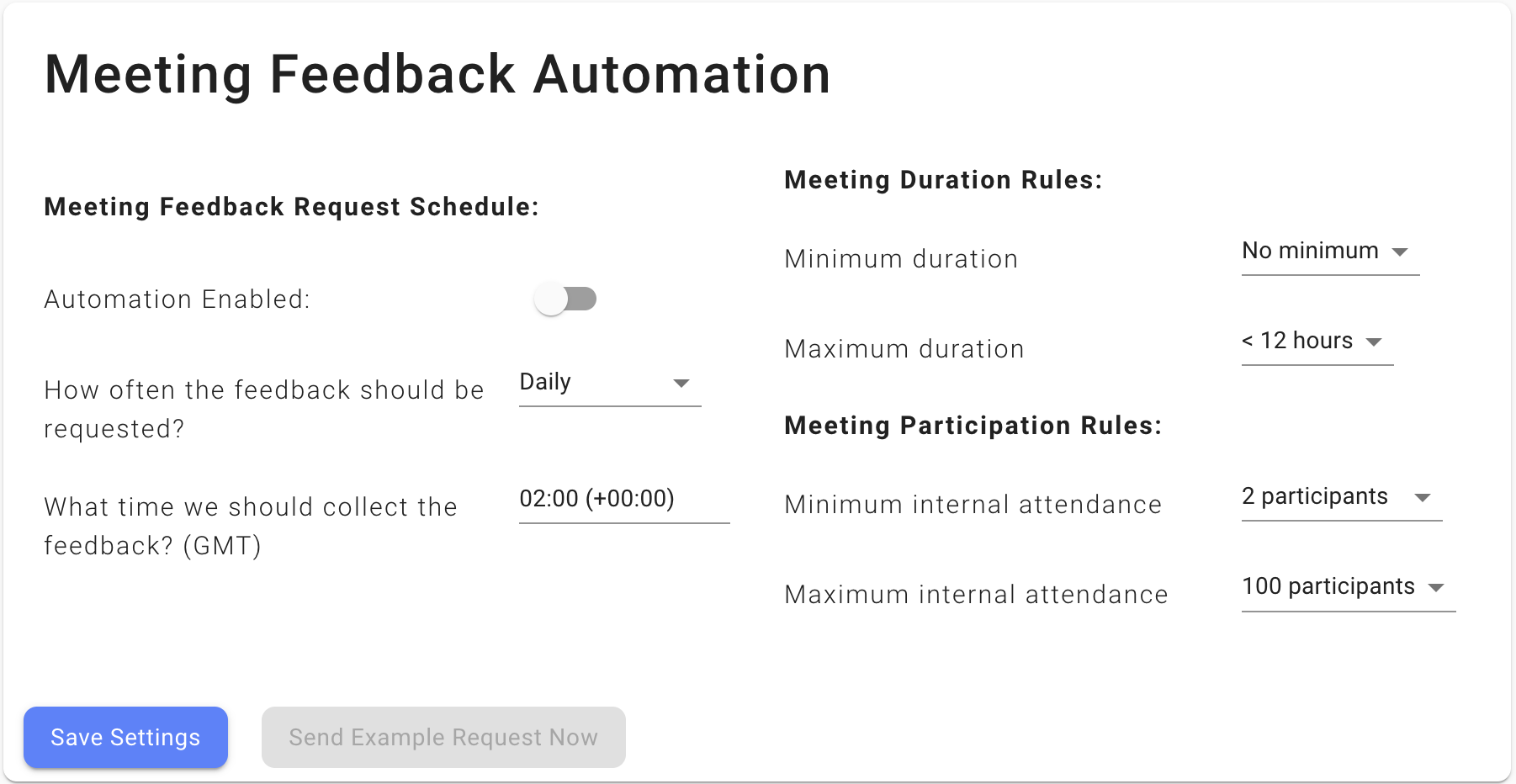
Moreover, meeting ratings and reviews provide richer and more nuanced data. While a survey might tell you that a participant was dissatisfied with a meeting, a review can tell you why. It allows participants to express their thoughts and feelings in their own words, providing valuable insights into what's working and what's not.
In our recent article on meeting analytics, we discussed how data can be used to improve meetings. Meeting ratings and reviews are a key part of this. They provide a wealth of data that can be analyzed to identify trends, spot issues, and track improvements over time.
Crafting the right questions is the cornerstone of any feedback collection process. The questions you ask can significantly influence the quality and usefulness of the feedback you receive. However, designing effective post-meeting survey questions is no small feat. It requires a deep understanding of your meeting objectives, the participants, and the kind of insights you're looking to gain.
To start, consider what aspects of the meeting you want feedback on. Is it the relevance of the topics discussed? The effectiveness of the communication? The clarity of the agenda? Once you've identified these aspects, you can start crafting questions around them. Remember to keep your questions clear, concise, and specific. Avoid leading questions that might influence the respondent's answer.
Read more: How to Collect Meeting Feedback That's Actionable
However, it's important to note that even with the most carefully crafted questions, traditional post-meeting surveys often face the challenge of low response rates. The process of filling out a survey can be time-consuming and tedious for participants, leading to lower engagement.
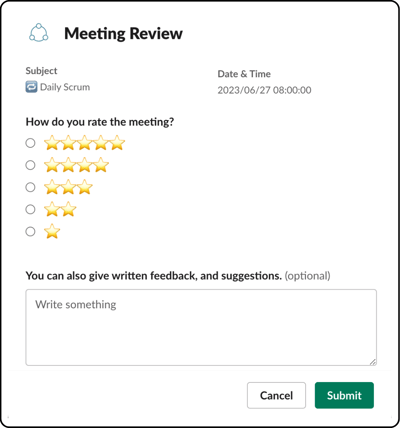
This is where Flowtrace's feature simplifies the feedback process, making it quick and easy for participants to provide their input. Instead of spending time crafting and answering lengthy survey questions, participants can rate the meeting and provide a brief review. This not only leads to higher response rates but also provides richer, more actionable insights. With Flowtrace, the burden of designing and maintaining a complex feedback system is lifted, allowing you to focus on what truly matters - using the feedback to improve your meetings.
Once you've designed your meeting feedback questions, the next step is to communicate the process to your team. Clear communication is crucial to ensure that everyone understands the purpose of the feedback, how to provide it, and how it will be used.
Start by explaining the importance of meeting feedback. Highlight how it can help improve meeting effectiveness, enhance collaboration, and ultimately, lead to better outcomes for the team. This will help your team understand the value of their input and encourage them to participate.
Next, walk your team through the process of providing feedback. If you're using a tool like Flowtrace, show them how to use the meeting ratings and reviews feature. Make sure to cover any questions they might have, such as when and how to provide feedback, and how their anonymity will be protected.
Finally, assure your team that their feedback will be taken seriously. Explain how the feedback will be analyzed and used to make improvements. This transparency will build trust and encourage honest, constructive feedback.
Remember, the goal of the feedback process is not just to gather data, but to foster a culture of continuous improvement. By communicating the process clearly and effectively, you can increase your team engagement and make them active participants in improving your meetings.
With your feedback system in place and your team on board, the next step is to start collecting and analyzing feedback. This is where the real magic happens, as the insights gained from the feedback can provide a roadmap for improving your meetings.
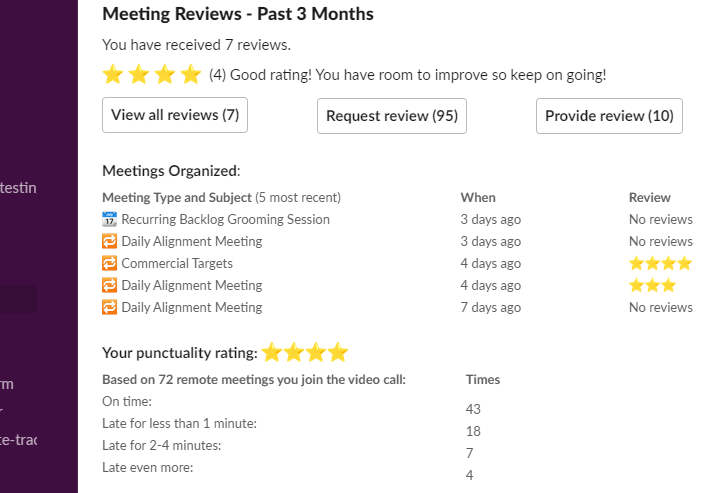
When using a tool like Flowtrace, collecting feedback is a breeze. The system automatically sends out the ratings and reviews requests to the participants of the targeted meetings. Participants can quickly rate the meeting and provide their review, making the process efficient and user-friendly.
Once the feedback starts rolling in, it's time to analyze it. You can easily arrange a meeting audit and Flowtrace brings all the data in your finger tips automatically. Look for trends in the ratings and common themes in the reviews. Are there certain aspects of the meetings that consistently receive low ratings? Are there recurring issues mentioned in the reviews? These patterns can provide valuable insights into what's working and what's not.
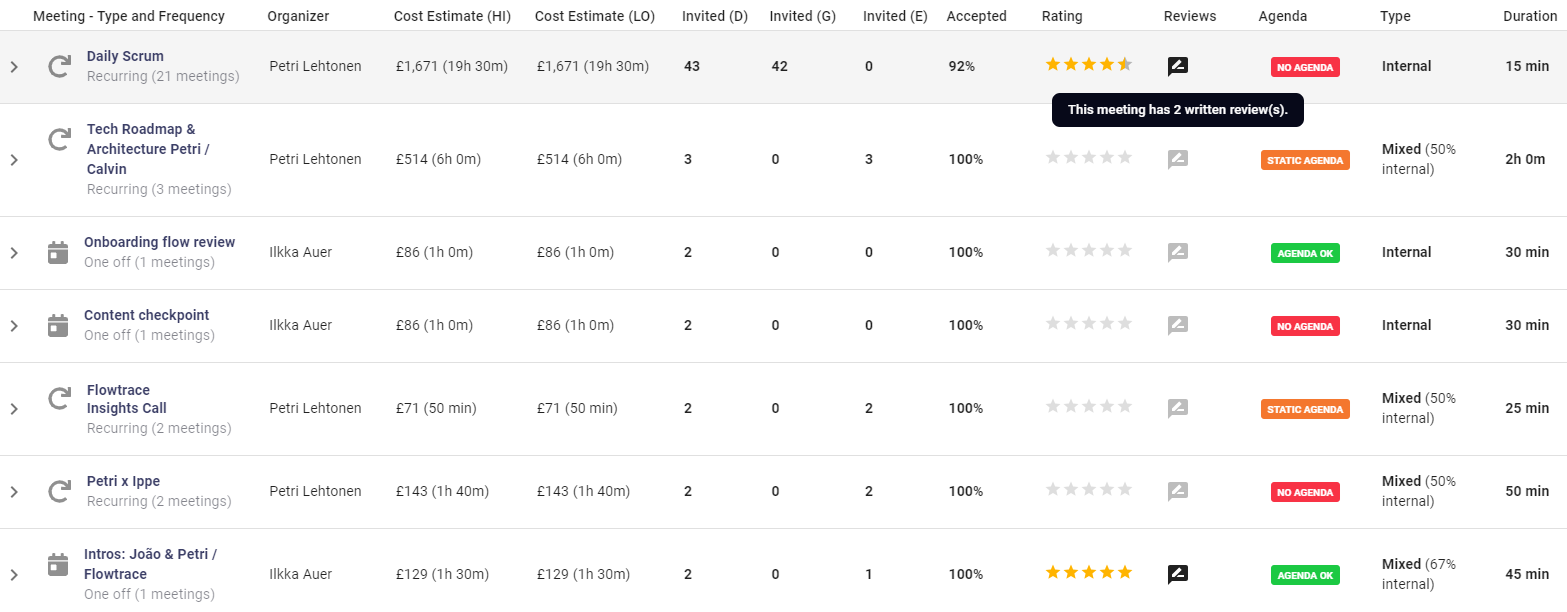
But don't just focus on the negatives. Also look for what's going well. High ratings and positive comments can show you what to keep doing in your meetings. Celebrate these successes with your team and encourage them to continue these practices.
Goal of collecting feedback is not just to gather data, but to use that data to drive improvements. With the insights gained from the feedback, you can start making changes to your meetings, turning them into more effective and engaging platforms for collaboration and decision-making.
Collecting and analyzing feedback is only half the battle. The real value of feedback lies in how you use it to drive improvements. After all, feedback is a tool for learning and growth, and it's most effective when it leads to action.
Start by addressing the most common issues identified in the feedback. If participants consistently rate certain aspects of the meetings low, consider what changes can be made to improve these areas. For example, if the feedback indicates that meetings often run over time, you might need to tighten up your agenda or improve time management.
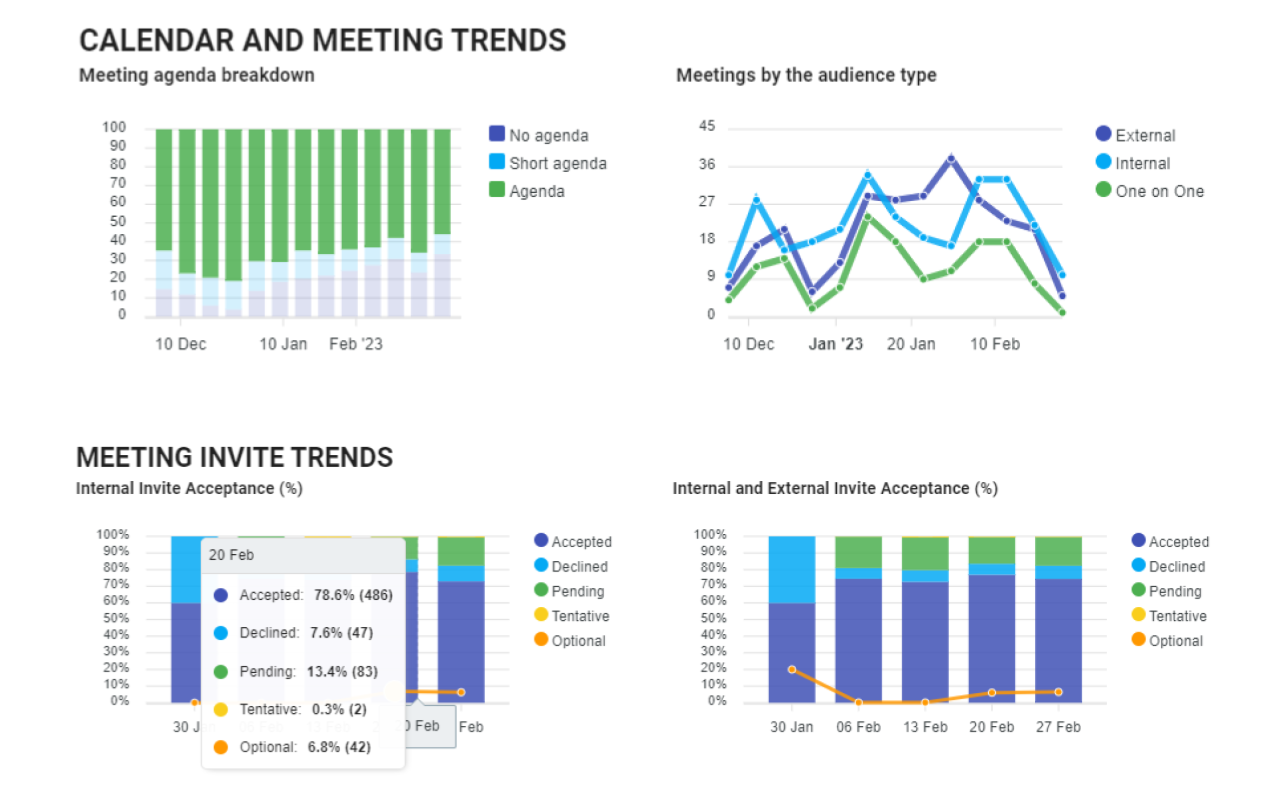
On the other hand, if the feedback highlights areas where your meetings are doing well, think about how you can maintain and build on these strengths. For instance, if participants appreciate the clear communication in meetings, continue to prioritize this in your meeting practices.
Implementing changes based on feedback is a process of trial and error. Some changes might lead to immediate improvements, while others might need further tweaking. Be patient, and remember that the goal is continuous improvement, not perfection.
One of the advantages of using a tool like Flowtrace is that it allows you to track changes over time. By utilising this data comparing feedback before and after implementing changes, you can see how effective your actions have been and adjust your strategies accordingly.
In our previous article on meeting productivity, we discussed how feedback can be used to improve the effectiveness of meetings. The same principle applies here. By implementing changes based on feedback, you can transform your meetings into more productive and engaging experiences.
Setting up a meeting feedback collection system is not a one-time task. It's an ongoing process that requires regular review and adjustment. As your team evolves and your meetings change, your feedback process should adapt accordingly.
Start by regularly reviewing the feedback you're receiving. Are you getting the insights you need? Are there questions that consistently yield unhelpful responses? If so, it might be time to revise your feedback questions or consider different aspects of the meeting to rate.
Next, look at your response rates. If they're lower than you'd like, consider ways to encourage more participation. This could involve reminding team members of the importance of their feedback, making the process even simpler, or providing incentives for participation.
Finally, consider the changes you've made based on feedback. Are they leading to improvements? If not, it might be time to try a different approach. Remember, the goal is not to get it right the first time, but to continuously learn and improve.
With a tool like Flowtrace, reviewing and adjusting your feedback process is easy. The system provides a wealth of data that can help you understand what's working and what's not, and make data-driven decisions to improve your feedback process.
In this article on meeting analytics, we discussed the importance of using data to drive improvements. The same principle applies here. By regularly reviewing and adjusting your feedback process, you can ensure it continues to provide valuable insights and drive meaningful improvements in your meetings.
Mastering meeting feedback is a journey, not a destination. It's about continuously learning, improving, and adapting. By setting up a meeting feedback collection system, you're taking a significant step towards making your meetings more effective and engaging.
But remember, the most important part of the feedback process is action. Feedback is a tool for change, and it's most powerful when it leads to improvements. So, take the insights you gain from the feedback, use them to make changes, and watch as your meetings become more productive and effective.
So, are you ready to master meeting feedback? The journey starts now. Let's transform our meetings, one review at a time.
Explore the evolution of meeting feedback from post-meeting surveys and feedback questionnaires to the efficient approach of meeting ratings and...
Discover how AI is transforming meeting feedback collection, analysis, and productivity. Learn about the shift from surveys to ratings and reviews.
Discover how meeting ratings, reviews and analytics can revolutionize your team's productivity, drawing lessons from e-commerce success stories.